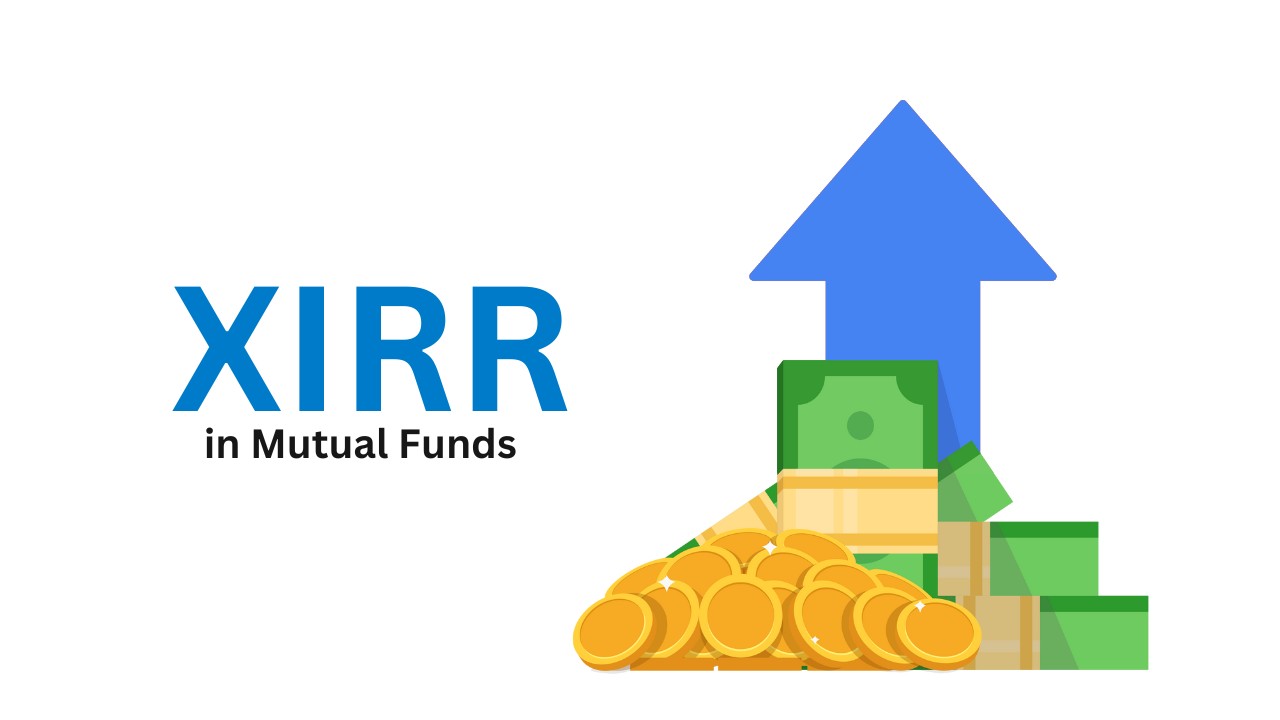Mutual funds have become a famous investment avenue due to their potential for steady returns and professional management. While most investors focus on the fund’s past performance, understanding how to calculate and interpret returns is equally critical.
जब आप म्यूचुअल फंड में निवेश करते हैं, तो आपका पैसा लगाना और निकालना अनियमित हो सकता है। ऐसे में XIRR (एक्सटेंडेड इंटरनल रेट ऑफ रिटर्न) मददगार साबित होता है। यह इन अनियमित लेन-देन के आधार पर वार्षिक रिटर्न की गणना करता है, जिससे आपको अपने निवेश के प्रदर्शन की सही तस्वीर मिलती है।
This blog explains XIRR, its importance, and how it differs from CAGR (Compound Annual Growth Rate). We’ll also discuss calculating XIRR and identifying what qualifies as a good XIRR in mutual funds.
म्यूचुअल फंड में XIRR क्या है?
XIRR का मतलब विस्तारित आंतरिक रिटर्न दर है। यह अनियमित समय पर किए गए नकदी प्रवाह के आधार पर निवेश पर वार्षिक रिटर्न की गणना करता है। पारंपरिक मेट्रिक्स जैसे CAGR से अलग, XIRR नकदी प्रवाह के समय और राशि दोनों का ध्यान रखता है। इसलिए, यह सिस्टमैटिक इन्वेस्टमेंट प्लान (SIP) और सिस्टमैटिक विद्ड्रॉल प्लान (SWP) के लिए खासतौर पर उपयोगी है।
उदाहरण के तौर पर, मान लीजिए आप म्यूचुअल फंड में हर महीने ₹10,000 निवेश करते हैं। एक साल बाद आपका कुल निवेश ₹1,20,000 हो जाता है, और इसकी कीमत बढ़कर ₹1,30,000 हो जाती है। XIRR हर ₹10,000 के निवेश के समय और अंतिम निकासी राशि के आधार पर सटीक वार्षिक रिटर्न की गणना करता है।
म्यूचुअल फंड में XIRR महत्वपूर्ण क्यों है?
अनियमित नकदी प्रवाह को ध्यान में रखता है
म्यूचुअल फंड निवेश आमतौर पर एसआईपी के माध्यम से किया जाता है, जहाँ नियमित रूप से समान राशि का निवेश किया जाता है। हालांकि, जीवन में अप्रत्याशित घटनाएँ हो सकती हैं, और कभी-कभी आप एसआईपी छोड़ सकते हैं, अतिरिक्त निवेश कर सकते हैं, या पैसा निकाल सकते हैं। इन बदलावों को ध्यान में रखते हुए, XIRR रिटर्न का एक अधिक वास्तविक माप प्रदान करता है।
एसआईपी रिटर्न को ट्रैक करने में मदद करता है
एसआईपी निवेश एक पसंदीदा तरीका है, लेकिन उनके रिटर्न का मूल्यांकन करना कठिन हो सकता है, क्योंकि पहले किए गए निवेश को बढ़ने में अधिक समय लगता है, जबकि हाल के योगदान जल्दी बढ़ते हैं। XIRR यह सुनिश्चित करता है कि यह यौगिक प्रभाव सही तरीके से दिखाया जाए।
बेहतर तुलना करने में मदद करता है
XIRR सभी फंडों या निवेश रणनीतियों के रिटर्न की तुलना को आसान और सही बनाता है। यह आपको हर निवेश का वास्तविक वार्षिक रिटर्न दिखाता है, चाहे नकदी प्रवाह का समय और राशि अलग-अलग हो।
XIRR बनाम CAGR: मुख्य अंतर
| विवरण | XIRR | CAGR |
| परिभाषा | समय के साथ असमान नकदी प्रवाह पर वार्षिक रिटर्न की गणना करता है। | यह एकमुश्त निवेश मानकर वार्षिक रिटर्न की गणना करता है। |
| उपयोगिता | एसआईपी, एसडब्ल्यूपी, या समय-समय पर किए गए निवेश और निकासी के लिए सबसे अच्छा है। | Ideal for lump-sum investments with no intermediate cash flows. |
| सटीकता | हर नकदी प्रवाह की राशि और समय दोनों को ध्यान में रखता है। | Assumes a single cash flow at the beginning of the period. |
| Complexity | यह एक जटिल गणना है क्योंकि इसमें दोनों, निवेश (इनफ्लो) और निकासी (आउटफ्लो) को ध्यान में रखना होता है। | Easy to calculate by taking the invested amount into account. |
Example for Better Understanding:
Imagine two investors
निवेशक ए: Invested ₹1,00,000 as a lump sum and redeemed ₹1,50,000 after three years. Here, CAGR can calculate returns accurately as there’s only one cash inflow and one outflow.
Investor B: Invested ₹10,000 every month for three years and redeemed ₹4,50,000 at the end. For this scenario, CAGR cannot account for the timing of each ₹10,000 investment, making XIRR the appropriate metric.
XIRR बनाम CAGR: मुख्य अंतर
| विवरण | XIRR | CAGR |
| परिभाषा | समय के साथ असमान नकदी प्रवाह पर वार्षिक रिटर्न की गणना करता है। | यह एकमुश्त निवेश मानकर वार्षिक रिटर्न की गणना करता है। |
| उपयोगिता | एसआईपी, एसडब्ल्यूपी, या समय-समय पर किए गए निवेश और निकासी के लिए सबसे अच्छा है। | Ideal for lump-sum investments with no intermediate cash flows. |
| सटीकता | हर नकदी प्रवाह की राशि और समय दोनों को ध्यान में रखता है। | Assumes a single cash flow at the beginning of the period. |
| Complexity | यह एक जटिल गणना है क्योंकि इसमें दोनों, निवेश (इनफ्लो) और निकासी (आउटफ्लो) को ध्यान में रखना होता है। | Easy to calculate by taking the invested amount into account. |
Example for Better Understanding:
Imagine two investors:
- निवेशक ए: Invested ₹1,00,000 as a lump sum and redeemed ₹1,50,000 after three years. Here, CAGR can calculate returns accurately as there’s only one cash inflow and one outflow.
- Investor B: Invested ₹10,000 every month for three years and redeemed ₹4,50,000 at the end. For this scenario, CAGR cannot account for the timing of each ₹10,000 investment, making XIRR the appropriate metric.
How to Calculate XIRR?
Calculating XIRR manually can be cumbersome as it requires iterative methods to solve for the return rate. However, tools like Excel or Google Sheets make the process simpler.
Steps to Calculate XIRR in Excel:
- List Dates: Create a column with all the dates when investments or withdrawals were made.
- Enter Cash Flows: In a second column, record the investment amounts as negative values (cash outflows) and the redemption amount as a positive value (cash inflow).
- Apply Formula: Use the formula =XIRR(values, dates) to calculate the annualised return.
| Date | Cash Flow |
| 01-Jan-2023 | -10,000 |
| 01-Feb-2023 | -10,000 |
| 01-Dec-2023 | 1,30,000 |
- Here, you invested ₹10,000 in January and February and redeemed ₹1,30,000 in December.
- Applying the Excel formula =XIRR(B2:B4, A2:A4) gives you an annualized return of around 32%.
What is a Good XIRR in Mutual Funds?
A good XIRR varies depending on the type of mutual fund and the market conditions.
- इक्विटी म्यूच्यूअल फंड्स : Since equity funds carry higher risk, they aim for higher returns. A good XIRR for equity funds typically ranges between 12% and 15% over the long term.
- डेब्ट म्यूच्यूअल फंड्स : Debt funds offer lower risk but deliver moderate returns. A good XIRR for these funds is around 6-8%, aligning with their safer nature.
Balanced/Hybrid Funds: For funds with a mix of equity and debt, 10-12% XIRR is considered reasonable.
CAGR vs. XIRR: When to Use What?
- Use CAGR when:
- Evaluating returns on lump-sum investments.
- Comparing the historical performance of funds.
- Use XIRR when:
- Tracking returns from SIPs or irregular investments.
- Evaluating returns for a portfolio with multiple cash flows.
- Calculating returns for funds with periodic withdrawals.
निष्कर्ष
Understanding and analyzing returns is crucial for mutual fund investors, especially when dealing with irregular cash flows like SIPs or withdrawals. This is where XIRR stands out, offering a precise calculation of annualized returns by accounting for the timing and size of each cash flow. Unlike CAGR, which assumes a single lump-sum investment, XIRR mirrors real-world investment patterns, making it a valuable tool for modern investors.
Knowing your XIRR empowers you to evaluate fund performance more effectively, compare different strategies, and align your portfolio with your financial goals.
How much XIRR is good?
In equity schemes, exceeding 12% is considered favourable, while in debt schemes, surpassing 7% is deemed good.
Can XIRR be negative?
Yes, a positive XIRR implies a profitable investment, and a negative XIRR indicates a loss.











